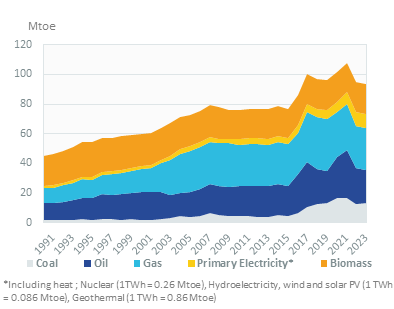-
-
 Energy and Climate Databases
Energy and Climate Databases- The most comprehensive and up-to-date annual energy database.
- Monitoring of technology providers in H2 supply chain.
- Monthly energy data on key energy markets.
- The most reliable and up-to-date power generation database.
- The essentials of LNG trade at your fingertips.
- Global monitoring of new and existing refineries.
- Analyse energy consumption and efficiency trends at world level. Benchmark countries.
- Have your database developed by a recognised expert of both energy and IT.
-
 Energy - Climate Forecasts
Energy - Climate Forecasts- Instant access to energy and emissions forecasts.
- Strategic, annual wholesale price projections backed by Enerdata's energy modelling expertise and our globally recognised POLES model.
- Wedges module showing a breakdown of the levers enabling to reduce emissions between two scenarios.
- Unique, independent projections of consumption by end-use.
- GHG Marginal Abatement Cost Curves.
- Benefit from proven models to draw your own energy scenarios and anticipate tomorrow’s challenges.
-
 Market Intelligence
Market Intelligence- 110 Energy and climate country reports
- A newsletter to receive the latest updates on evolving technologies and policies.
- Global energy news and analyses curated daily.
- Enerdata’s experts bring you the essentials about your market and competitors.
-
-
-
 Market Analysis
Market Analysis- Understanding key consumption trends and drivers across sectors.
- Granular and exclusive insight to address the most pressing business and strategic issues.
- Expertise in strategic and business intelligence, with fine-tuning to the market’s specificities.
-
 Energy - Climate Scenarios
Energy - Climate Scenarios- Providing the outlook of an energy commodity in mid to long term time horizons.
- Sector and driver specific energy demand forecasting.
- Assess the evolution of energy prices on the international and regional markets, as well as end-users prices.
- Enerdata guides you through pathways to reach climate targets.
- Supporting local authorities in their decarbonisation strategies.
-
 Climate Strategy and Policy Evaluation
Climate Strategy and Policy Evaluation- Cutting-edge quantitative tools and relevant indicators to monitor and evaluate evolutions on worldwide energy markets.
- Analysis of the most cost-effective options to reduce emissions.
- Quantified simulation and analysis of pledges for climate change negotiations.
- Breakdown and analysis of carbon markets.
- Enerdata guides you on the most beneficial policy or investment options.
- Turning climate objectives into concrete action plans.
-
 Training
Training- Understand different policy targets and measures on energy efficiency.
- How to measure energy savings?
- Energy Forecasting is a 2 days training to learn to design and interpret energy forecasts.
- Energy statistics training allowing to create energy balance with supply, transformation and consumption and understanding the international energy statistics regulations.
- Initiation to EnerMED level 1is the training to approach on the most powerful energy demand forecasting model.
-
-
Resource Centre
Pakistan Key Figures
- Population:
- 236 million
- GDP growth rate:
- 6.19 %/year
- Energy independence:
- 73.3%
Data of the last year available: 2022
- Total consumption/GDP:*
- 74.4 (2005=100)
- CO2 Emissions:
- 0.69 tCO2/capita
- Rate of T&D power losses:
- 14.1%
* at purchasing power parity
View all macro and energy indicators in the Pakistan energy report
Pakistan Related News
View all news, archive your new and create your own daily newsletters only on your topics/countries of interest with Key Energy Intelligence
Pakistan Related Research
Benefit from up to 2 000 up-to-date data series for 186 countries in Global Energy & CO2 data
A data overview is available in the global energy statistics app
Total Energy Consumption
Per capita consumption is about 0.5 toe, including 478 kWh of electricity (2022).
The country's total consumption dropped by 10% in 2022, after a rapid increase between 2014 and 2021 (4%/year). The progression was more moderate between 2008 and 2013 (1.5%/year).
Graph: CONSUMPTION TRENDS BY ENERGY SOURCE (Mtoe)

Interactive Chart Pakistan Total Energy Consumption
Benefit from up to 2 000 up-to-date data series for 186 countries in Global Energy & CO2 data
View the detailed fondamentals of the market at country level (graphs, tables, analysis) in the Pakistan energy report
Crude Oil Production
Oil production has fluctuated around 4-5 Mt since 2012 (4.1 Mt in 2022). Production supplies around 20% of the country's needs. Crude oil imports decreased slightly to 7.5 Mt in 2022, after two years at a higher level (about 9 Mt in 2020 and 2021).
Interactive Chart Pakistan Crude Oil Production
Benefit from up to 2 000 up-to-date data series for 186 countries in Global Energy & CO2 data
Additionally, for more detailed information on refineries, you can request a sample of our Asia Refineries Dataset
Renewable in % Electricity Production
AEDB, Alternative Energy Development Board, is the national agency for the promotion of renewables.
The new Alternative and Renewable Energy Policy (ARE, 2019) included a target of at least 20% of alternative and renewable energy (excluding hydroelectricity) in the power capacity in 2025 and 30% in 2030. With hydropower, this corresponds to a share of 60%. In 2020, Pakistan announced its intention to reach 27 GW of solar by 2047.
Interactive Chart Pakistan Share of Renewables in Electricity Production (incl hydro)
Benefit from up to 2 000 up-to-date data series for 186 countries in Global Energy & CO2 data
Learn more about renewables in the Mini grid Africa & Asia markets for village electrification
CO2 Fuel Combustion/CO2 Emissions
In its updated NDC (2021), Pakistan committed to cut its GHG emissions in 2030 by up to 50% relative to a BAU scenario (unconditional target of 15% and conditional target of 35%).
CO2 emissions from fuel combustion dropped significantly in 2022 to around 163 MtCO2 (-18% compared to 2020 historical peak), partly due to lower coal use in the power sector, linked to higher demand and prices on coal imports. Previously, emissions increased rapidly from 2013 to 2017 (+9%/year) and from 2019 to 2021.